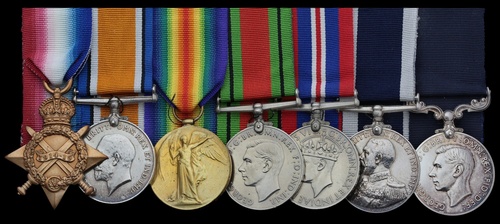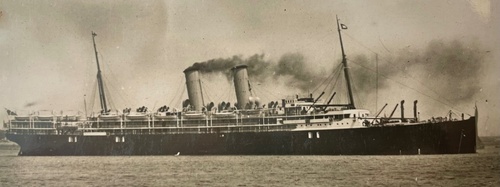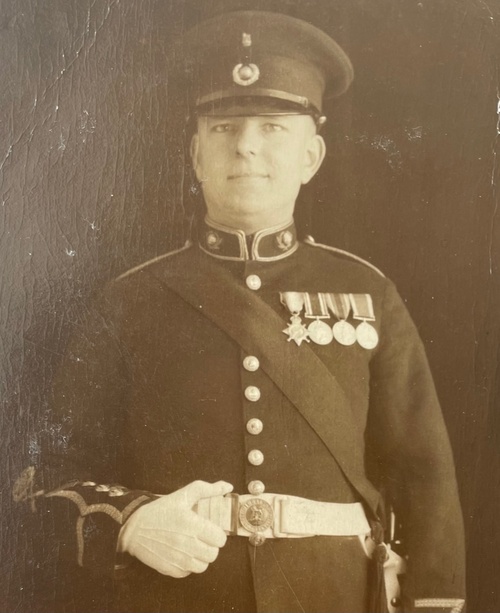Auction: 22002 - Orders, Decorations and Medals
Lot: 236
(x) A 1951 Royal Marines M.S.M. group of seven awarded to Lieutenant (Quartermaster) A. S. Carn, Royal Marines
1914-15 Star (Ch.16725, Cpl. A. S. Carn, R.M.L.I.); British War and Victory Medals (Ch.16725 Sgt. A. S. Carn. R.M.L.I.); Defence and War Medals 1939-45; Royal Navy L.S. & G.C., G.V.R. (Ch.16725 A. S. Carn. Cr. Sgt. R.M.); Royal Marines Meritorious Service Medal, G.VI.R. (Ch. 16725 Q.M.S.I. A. S. Carn. 28.2.1951.), very fine (7)
M.S.M. awarded February 1951.
Alfred Samuel Carn was born on 25 April 1892 at Beccles, Suffolk, the son of Alfred and Emily Carn, the youngest of their five children. His father was manager of an insurance office. The family moved to London and in 1901 they were living in Tooting. On leaving school Alfred Carn worked as a grocer's assistant.
Carn enlisted as a Private in the Royal Marine Light Infantry on 13 August 1910. He was five feet, nine inches tall, with dark brown hair, grey eyes and a dark complexion. After training at the recruit depot at Deal, he was assigned to the Chatham Division; throughout his service, he returned to this depot between his drafts at sea. In 1912 he served at sea for a few weeks in the battleships King Edward VII and Triumph. From January 1913-July 1914 he was part of the nucleus crew in the Ocean, an obsolete battleship assigned to the Reserve Fleet and stationed at Pembroke Dock in Wales.
In July 1914 there was a practice mobilization of the fleet; this had been planned for some time but coincided with the crisis following the assassination of the Austrian Arch-Duke. Carn was transferred to the Magnificent; one of the nine Majestic class battleships completed in 1895. These were some of the oldest ships still in commission and were unsuitable for front-line service. The ship was first stationed in the Humber, as part of the short-lived 9th Battle Squadron; when the squadron was dissolved the following month she was sent to Scapa Flow for harbour defence duties. It must have been frustrating for a keen young man like Carn to be assigned to such obsolete ships which, clearly, would not see any action, at a time when several other ships had already taken part in victorious battles.
In October 1914 Carn was promoted Corporal and on 23 November 1914 he was transferred to the Otway, an armed merchant cruiser (AMC). She was built as a liner for the Orient Steam Navigation Company of Glasgow and launched in 1909. She had a displacement of 12,077 tons, a speed of eighteen knots and carried 1,095 passengers. She had four sister ships which enabled the Orient Line to offer the travelling public guaranteed departures every other week for Australia and New Zealand. The Admiralty requisitioned her on 11 November 1914. She was converted for naval employment in a London shipyard, with eight 6-inch guns and two 6-pounders. As an AMC her company consisted of forty-five officers and 320 ratings. Of the officers, only the CO, Captain E.L. Booty MVO and three others were regulars, the rest came from the RNR.
Otway was assigned to the 10th Cruiser Squadron. Most of the ships of this squadron were also armed merchant cruisers; they were almost constantly at sea, deployed in the stormy seas between the north of Scotland, Iceland and Norway where their role was to enforce the blockade of Germany. What this meant in practice was to prevent any German ships passing in either direction, and inspect all neutral vessels bound for Scandinavia or the Netherlands to ensure that they were not carrying any cargo destined for Germany. When a neutral ship was intercepted, the blockading ship ordered it to halt, then sent a small party consisting of an officer and three or four seamen or marines to board her. The officer would inspect the ship's papers, they might carry out a cursory inspection and, if nothing suspicious were found, the ship would be allowed to proceed. If contraband were detected, or if the officer were suspicious, a prize crew was put aboard and the ship was directed to proceed to a U.K. port (often Kirkwall in the Orkneys) for a more thorough inspection.
Otway was assigned to patrol line 'C' between the Hebrides and the Faroes. In March 1915 she had a frustrating encounter with the Norwegian liner Bergensfjord, a notorious blockade-runner. Acting on intelligence, Otway intercepted her on the 29th as she was on passage from New York and sent her to Kirkwall with a prize crew. Despite her best efforts to evade or out-run the patrols, it was already the third time the liner had been sent in. She was found to be carrying seventeen Germans of military age, one of them a Reserve officer, all equipped with false Norwegian passports. On the directions of the Foreign Office all were released and permitted to continue their voyage. She had another encounter with a Scandinavian liner in October that year when on her way to assist with the salvage of a sinking ship. She encountered the United States, a Danish liner, and sent her in to Kirkwall. This time the passengers included an Austrian aviator. As well as modern liners, the blockading ships also intercepted small sailing vessels and some of the prize crews experienced very difficult passages when they encountered adverse weather. On 21 December 1915, for example, Otway intercepted the barque Skomvaer on passage from Buenos Aires to Norway with a cargo of Quebrachi wood. A prize crew of a Sub-Lieutenant, a Midshipman and four seamen were put aboard with rations for eight days, with orders to bring her to Lerwick. For eleven days there were strong easterly winds and she could make no progress. On a couple of occasions she encountered other ships of the squadron which supplied more provisions. The winds then veered round to the south-west and she reached the approaches to Lerwick when a gale sprang up and she was blown far off course. After nearly a month at sea, with provisions almost exhausted, the Sub-Lieutenant agreed to make for Norway and the Skomvaer arrived at her original destination. The prize crew could have been interned but the Norwegians kindly permitted them to embark in a Norwegian steamer for Newcastle. From there they caught a train to Liverpool and re-joined Otway.
There were some dramatic reversals of fortune as German U-boats enforced their own blockade. In November 1916 Otway intercepted the Norwegian Older. The latter had sailed from Wales with a cargo of coal, bound for Gibraltar. She was captured by a U-boat which put a prize crew aboard with orders to bring her to Kiel. The crews of an Italian steamship and a British trawler which had been sunk by the submarine were also embarked. When Otway's boarding crew approached the Older, the Germans defied them and reported that they had placed bombs ready to scuttle the ship. All aboard were then transferred to the Otway. The bombs did not explode and next morning Older's crew re-embarked and brought her to port.
On another occasion it was one of Otway's crew who became a prisoner. The following January she intercepted a neutral ship and put aboard a prize crew with orders to bring her to a British port for inspection. Just a few hours after the ships separated, a U-boat stopped the ship and took the officer prisoner. Surprisingly, the ship was released with the remainder of the prize crew.
Carn left the Otway on 21 March 1917. Four months later UC-49 torpedoed her off the Hebrides and she sank with the loss of ten lives. Three more of Carn's former ships were sunk during the war, namely the King Edward VII, Triumph and Ocean - he could congratulate himself on the fortunate timing of his transfers.
He served ashore from March-December 1917, and was then drafted to the light cruiser Lowestoft in the Mediterranean. He was promoted to Sergeant a couple of months later. In January 1919 he joined the Caesar, depot ship at Port Said. She was another of the old Majestic class battleships from the 1890s. In June she traversed the Dardanelles and entered the Black Sea, where she was depot ship for the British forces operating against the Bolsheviks in south Russia. She thus earned the distinction of being the last of the pre-dreadnought battleships to see operational service.
At the end of 1919 Carn spent two months at Malta, then in January 1920 was drafted to the light cruiser Cardiff, flying the flag of Rear-Admiral George Hope, commanding the 3rd Light Cruiser Squadron. The ship proceeded to Constantinople, then to Odessa, where Hope formed the view that the city could not be defended against the advancing Bolsheviks. Over the following two months the cruiser operated off the Crimean peninsula, assisting with the evacuation of desperate White Russians. On 6 November 1920 the Cardiff embarked Charles, the former Emperor of the Austro-Hungarian Empire, and his wife Zita, and carried them from Romania to Madeira, their place of exile.
Carn returned to England in December 1920 and served ashore for the next three and a half years. He was variously employed in the RM Orderly Office and as Clerk in the Commandant's office. On 21 July 1921 he married Mary Price at Brentwood, Middlesex. In June 1923 the Royal Marine Light Infantry and the Royal Marine Artillery merged. In 1924 he began his last draft at sea in the light cruiser Calypso, in the Mediterranean. Whilst serving in this ship he was promoted Colour-Sergeant and awarded his L.S. & G.C. Medal. In 1926 he returned to Chatham where he was promoted Quartermaster Sergeant and Instructor of Gunnery in 1929. He retired in August 1931.
Carn was mobilized at the time of the Munich crisis in September 1938 but released after a week. Presumably he was called up again on the outbreak of the Second World War, but information on his service during the first two years of the war is not available. On 22 August 1941 he was promoted to the rank of Warrant Officer and appointed Regimental Sergeant Major at the RM recruit depot and training camp at Thurlestone, south Devon. In January 1943 he was stationed at Matapan Camp in Wales; the following month he was commissioned as Lieutenant (Quartermaster). In October 1943 he was appointed to Gosling, a training establishment near Warrington, Lancashire. In September 1944 he was married to Amelia Berry at Merioneth, Wales (his first wife having died in 1938). Carn was demobilized in August 1945 and returned to his home in Hanwell, London.
In February 1951 Carn was awarded the Royal Marines M.S.M., with an annuity, but this depended on availability of funds and Carn did not begin to receive his annuity until 1972, at the age of eighty.
Subject to 5% tax on Hammer Price in addition to 20% VAT on Buyer’s Premium.
Sold for
£800
Starting price
£600









